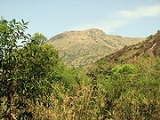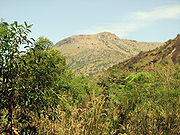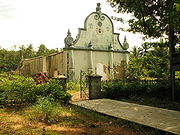
Udayagiri Fort
Encyclopedia
Fort in Tamil Nadu

Location
The fort in Tamil NaduTamil Nadu
Tamil Nadu is one of the 28 states of India. Its capital and largest city is Chennai. Tamil Nadu lies in the southernmost part of the Indian Peninsula and is bordered by the union territory of Pondicherry, and the states of Kerala, Karnataka, and Andhra Pradesh...
is located at a distance of 14 km from Nagercoil
Nagercoil
Nagercoil is the 12th largest city in the southernmost Indian state of Tamil Nadu and a municipality and administrative headquarters of Kanyakumari District...
town in Kanyakumari District
Kanyakumari District
Kanyakumari District ) is a district of Tamil Nadu state, India and is the southernmost land area of mainland India.The district is the second most urbanised district in Tamilnadu, next only to Chennai and ahead of Coimbatore. It also has the highest literacy and education levels in the...
. The fort is situated on the Thiruvananthapuram
Thiruvananthapuram
Thiruvananthapuram , formerly known as Trivandrum, is the capital of the Indian state of Kerala and the headquarters of the Thiruvananthapuram District. It is located on the west coast of India near the extreme south of the mainland...
-Nagercoil
Nagercoil
Nagercoil is the 12th largest city in the southernmost Indian state of Tamil Nadu and a municipality and administrative headquarters of Kanyakumari District...
National highway at Puliyoorkurichi. This was the most important military barracks of the Travancore
Travancore
Kingdom of Travancore was a former Hindu feudal kingdom and Indian Princely State with its capital at Padmanabhapuram or Trivandrum ruled by the Travancore Royal Family. The Kingdom of Travancore comprised most of modern day southern Kerala, Kanyakumari district, and the southernmost parts of...
rulers, when Padmanabhapuram was their capital. 8°14′38.4"N 77°19′55.2"E
History
It had been originally built in the 17th century, and then rebuilt later by Maharaja Marthanda VarmaMarthanda Varma
Marthanda Varma , was the founder of the Indian Hindu feudal kingdom of Travancore from Venad SwaroopamHe ruled from 1729 till his death in 1758, having succeeded his maternal uncle Dharma Raja.King Marthanda Varma is usually credited as the "founder of Kingdom of Travancore" from...
of Travancore in the 18th century.
Enclosing an area of about 90 acres (36 ha), with an isolated hill 260 feet (79 m) high, the fort contains an old foundry which was used for casting guns.
The fort was rebuilt during the reign of Marthanda Varma
Marthanda Varma
Marthanda Varma , was the founder of the Indian Hindu feudal kingdom of Travancore from Venad SwaroopamHe ruled from 1729 till his death in 1758, having succeeded his maternal uncle Dharma Raja.King Marthanda Varma is usually credited as the "founder of Kingdom of Travancore" from...
, Venad King, during 1741-44 under the supervision of Eustachius De Lannoy
Eustachius De Lannoy
Eustachius Benedictus de Lannoy was a Flemish naval commander of the Dutch East India Company, who was sent by the company to help establish a trading post at Colachel, Southern India, but was defeated at the Battle of Colachel by...
, a Flemish naval commander of the Dutch East India Company, who later served as the Chief of the Travancore
Travancore
Kingdom of Travancore was a former Hindu feudal kingdom and Indian Princely State with its capital at Padmanabhapuram or Trivandrum ruled by the Travancore Royal Family. The Kingdom of Travancore comprised most of modern day southern Kerala, Kanyakumari district, and the southernmost parts of...
Army.
In the early days, the fort was of strategic importance. Prisoners captured in the campaign against Tippu Sultan were confined in the fort for some time. In 1810, the East India Company's Army under Colonel Leger marched into the Travancore State through the Aramboly Pass to quell a rebellion under the leadership of Velu Thambi Dalava.
In the later years, the English East India Company's troops were stationed there till the middle of the 19th century. Foundry for the manufacture of guns, mortars and cannon balls were also established within the fort under the supervision of the General.
Architecture

The tombs of the Dutch Admiral Eustachius De Lannoy
Eustachius De Lannoy
Eustachius Benedictus de Lannoy was a Flemish naval commander of the Dutch East India Company, who was sent by the company to help establish a trading post at Colachel, Southern India, but was defeated at the Battle of Colachel by...
, (in whose honour the fort was once called Dillanai Kottai— De Lennoy's Fort), and of his wife and son can still be found inside a partly ruined chapel in the fort.
De Lannoy's body was buried within the fort and a chapel was built at his burial site . De Lannoy's tombstone lies within the walls of the ruined chapel. The inscriptions on his stone are both in Tamil and in Latin. His wife and son were buried by his side.
Recently, officials of the Department of Archaeology found an underground tunnel within the fort.
Presently, the fort has been turned into a bio-diversity park by the Tamilnadu forest department, with sites of historical importance, such as De Lannoy's tomb, remaining as protected archaeological sites under the Archaeological Department of India.
Location
The fort in Andhra PradeshAndhra Pradesh
Andhra Pradesh , is one of the 28 states of India, situated on the southeastern coast of India. It is India's fourth largest state by area and fifth largest by population. Its capital and largest city by population is Hyderabad.The total GDP of Andhra Pradesh is $100 billion and is ranked third...
state is located in Udayagiri Village
Udayagiri, Nellore district
Udayagiri is a Mandal in the Nellore district of the state of Andhra Pradesh in India.-Geography:Udayagiri is located at . It has an average elevation of 230 meters .-History:...
in Nellore district
Nellore district
Sri Amarajeevi Potti Sri Ramulu Nellore District is one of the 23 districts of Andhra Pradesh. Nellore is famous for high paddy field, and so it got its name from "Nelli". The population of the district was 2,966,082 of which 22.45% were urban as of 2011....
. It is located 96 km from Nellore city. 14°51′55.8"N 79°16′26.33"E
History
The fort was built by Gajapatis and Vijayanagara kingsVijayanagara Empire
The Vijayanagara Empire , referred as the Kingdom of Bisnaga by the Portuguese, was an empire based in South Indian in the Deccan Plateau region. It was established in 1336 by Harihara I and his brother Bukka Raya I of the Yadava lineage. The empire rose to prominence as a culmination of attempts...
in the 14th and 15th centuries. The army of Krishna Deva Raya attacked the fort. The fight lasted for 18 months and resulted in the end of Gajapatis rule from the Telugu
Telugu people
The Telugu people or Telugu Prajalu are an ethnic group of India. They are the native speakers of the Telugu language, the most commonly spoken language in India after Hindi and Bengali...
region. It was later ruled by chieftains of the Nawabs of Golconda
Golconda
Golconda may be:Places:* Golkonda, ruined city and fortress in India* Golconda, Illinois, town in the United States* Golconda, Nevada, former town in the United StatesOther:* Golconda...
and Arcot. During the rule of the Gajapathis and the Vijayanagara rulers, this town grew to great splendour and the ruins of 365 temples reflect the sculpture and architecture of various periods.

